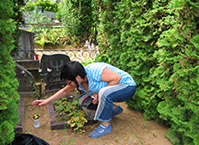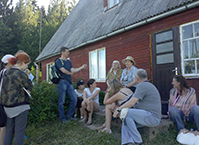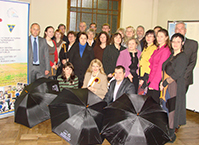The parable about the hidden treasure conducted and the old ancient settlement
Categories: Holidays and traditions, Anita Locmele
Story-teller: “But then again there is a belief that treasure is hidden in the place, where the evil spirit often lures. However, scientists explain that there is something connected with underground water streams or something else! And so, in our Puncuļova village, I say our, mine are both Danska and Puncuļova villages, and, and, here a lot of people got lost in one place in the field. In a clear field, there were no trees, nothing, and they lost their way. Here, in Danska village there is place where people always get lost. It is the field, there were some small bushes before, but, there has always been a trail to the neighbouring village, but people always got lost there; it’s interesting. And there is a wood in Danska village, which people try to avoid crossing at night, though there, maybe, is a trail to the house beyond that wood, but people try to avoid it. So, a man had had a drop too much and went there at night, and he stayed there for the whole night, but he tried to keep to the trees, because he knew that there were marsh pools in that wood. Everything is dry, but there are marsh pools in that wood. Such are … such are the tales, that in our marsh pools, probably, Napoleon or someone else and what they, you see, actually one man told me that there was money immersed in those pools.”
Interviewer: “Napoleon, who burned down Kārsava? The furthest place he reached, I read in old newspapers, some Napoleon’s brigades had wandered off and burned Kārsava down.”
Story-teller: “But that old man told me that there was a road through that wood, where… No, that couldn’t have been Napoleon, definitely not.”
Interviewer: “Isn’t it Tīsa pine forest somewhere there?”
Story-teller: “No, Tīsa pine forest is another, with its, lost people. But...”
Interviewer: “Could you tell me about Tīsa pine forest?”
Story-teller: “But that Olutaji wood in Danskeji goes to the old hill fort. And there was the old hill fort, no, it was on both sides of the road, obviously, it had been a hill fort, but it must have been burned down. Because it was easier to get there, though boggy places are everywhere around there. And he said, that there was a road made of logs and he, being a boy, saw those, I don’t know, if they are better preserved in the marsh or what, I don’t know, in such a boggy place, it’s said that, my grandfather showed us those log, I mean, logs, they were half-putrid, those logs had been used to build the road. Maybe, I don’t know, but that first hill ort was burned down, yes.
But Tīsa pine forest, I don’t know, people say, there used to be the punishment square of the former hill fort. Different punishments were executed there. And as if they had shacked up with each other there, you see, earlier it was forbidden for an unmarried woman to have a child. And it turned out that they were relatives by blood, cousins or what, I don’t know. And a child was born and they got stoned to death. That was their punishment. They were put into a pit, everybody threw stones and they died. And therefore Tīsa pine forest is haunted.”
Images
Audio
Researcher: Dr. philol. Gatis Ozoliņš, Daugavpils Universitāte











